Terril Hebert writes [via ammoland.com]: The number of rounds fired in citizen-involved self-defense encounters is hard to gauge. I have searched high and low for answers, but even the FBI doesn’t keep that sort of data. Studies, including that conducted by Kleck and Gertz in their 1995 book Armed Resistance to Crime point out that more than 92 percent of all self-defense uses of firearms don’t involve firing the gun.
But what about that remaining eight percent of the time when you have to pull the trigger? There isn’t any clear data on this, and there are many scenarios to justify any extreme. Suffice to say that a high capacity pistol will probably get you through any issue.
But many of us carry small, pocket sized handguns that sacrifice handling and capacity for program compliance.
Pocket 380s and 9mms fall into this category, but they do benefit from being easy to reload with additional magazines, though this is more awkward given the abbreviated controls of the gun. The situation is more precarious if you choose a wheel-gun as your concealed carry handgun. We know revolvers have their place and benefits over auto-loaders, but simple reloads aren’t one of those things.
So what if you empty your revolver in a fight and need to reload? There are quite a few options to get the job done, but which is best? Let’s have a look.
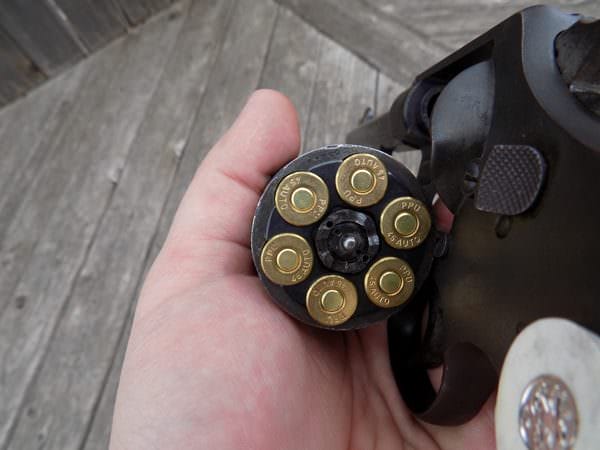
What Kind of Guns Are We Talking About?
Double action self-defense revolvers used to be the gun of choice, but today they are one of many excellent self-defense options out there. A few of us are carrying full-sized or small-bore revolvers for personal defense, the most common choice today are small-framed snub-nosed revolvers in 38 Special.
This is worth mentioning because these handguns have more quirks to overcome when it comes to defense and reloading. We will get into some of these later, but the main point is that most of these “snubbie 38s” will carry only five rounds on board.
You know their names: The Smith & Wesson J-frame, Taurus m85, Ruger LCR, etc. We can talk about higher pressure +P and non +P ammo another time, but suffice to say that the guns will need to be disassembled and put back together again every five rounds.
The question is: How to reload fast with as little fuss as possible?

Loose Rounds?
It is common for me to see a revolver shooter at the range reloading his gun with loose ammunition, one or two rounds at a time.
Until the 1970s, this was the way revolvers loaded in the field, both recreationally and in law enforcement. Police officers usually carried their spare cartridges on belt loops or dump pouches attached to the belt.
Pulling a buckle would release all six cartridges into the hand for reloading. These dump pouches were fast to deploy, but even that wasn’t a perfect solution. No matter how you slice it, loading with loose ammo is cumbersome enough at the range without ducking your head to see what you are doing. It would be even harder to do under stress.
The 1970 Newhall Massacre and FBI 1986 Miami Dade Shootout produced examples of officers who were shot down while trying to reload their revolvers with loose ammunition. In practice, there is indeed the temptation to keep loading until the cylinder is full when a partial reload would be preferable.
Reloading Loose Rounds: This method requires no investment in extra gear and is useful when practicing partial reloads where you fire two or more rounds, pluck the spent brass and push in more, just in case.
Speed Strips

The problem with loading loose ammunition when encountering danger was obvious, and one of the first solutions was developed by John Bianchi in the late 1960s. Bianchi Speed Strips remain very popular and readily available, as are their imitators like Tuff Strips.
Where I was unable to find speedloaders, I was still able to find Speed Strips on the shelf. These rubber strips hold six rounds with an almost stripper clip type of appearance.
Trying to use them right out of the box with my Smith & Wesson Model 638 revolver was a mistake. The strips right out of the packaging are very rigid and require some stretching in order to work correctly.
After a minute of using them for hand exercise, I snapped more rounds onto them and went to loading. Snap two rounds into the cylinder then pull up and away with the strip. Turn the cylinder slightly and repeat.
With some practice, I was able to get my revolver reloaded in about eight seconds with much less fumbling than with loose rounds.
The benefit of Speed Strips is their profile, which is flat much like a semi-auto’s magazine. Easy and discreet to carry your spare ammunition in your pocket or a pouch on the belt.
These are the way to go when it comes to partial reloaders as you can snap in two rounds with a well… snap of the wrist. Using the overhanging fingers to feel for the edge of the cylinder allowed me to reload without looking at the gun, though it took some real trying to do so.
Moon Clips
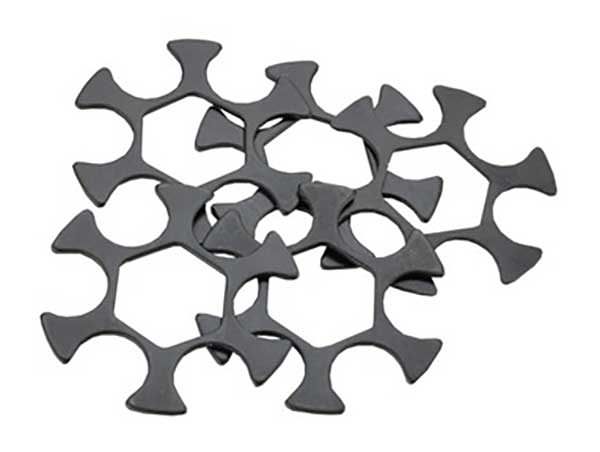
The concept has caught on, not just in auto cartridge chambered revolvers, but in pistols machined to take Moon Clips with standard rimmed revolver cartridges. If you want absolute speed, this isn’t a bad option.
The only downside is the fragility of the system. The tempered steel clip could be damaged or bent when dropped on the ground or otherwise abused.
If bent clips are used again, they could bind the gun up, preventing operation. Avoiding damage at the range is easy enough, but I wouldn’t feel content with simply throwing a moon clip in my bare pocket and hoping for the best.

Speedloaders
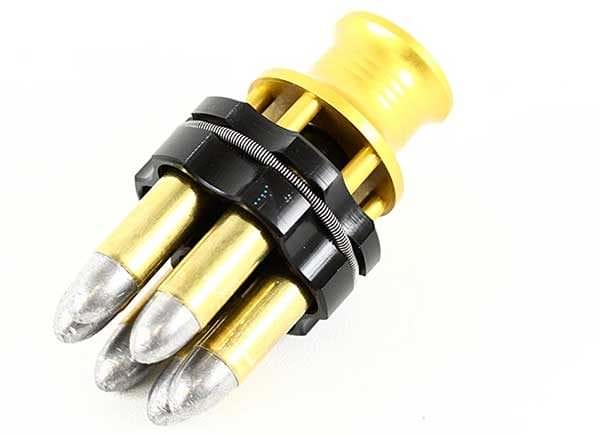
The Revolver Speedloader became widely used after the shock of the 1970 Newhall Shooting, and today it is most available and straightforward way to speed reload a revolver.
The fundamental principle is a body that holds the ammunition in a circular fashion as it would be in a revolver cylinder, and a means of releasing the rounds. There are different brands with different operating systems that have their tricks and benefits, and I have tried quite a few of them.
Along with Bianchi’s Speed Strips, the HKS and Safariland Comp loaders are the most available ways of speed reloading your snubbie revolver. Both are durable, yet the bodies of the loaders are made of polymer.
The HKS is easy to load by dropping in your rounds, twisting the knob to secure them, then rotating it in the other direction to release the rounds into the gun.
The Safariland relies on a gear that is activated by pushing the base of the loader against the cylinder face to release its rounds. It is loaded by dropping in the rounds, pushing the bullet noses against a flat surface, and then twisting the gear.
The HKS is the least expensive and most available of the two, but the use of a manually twisted knob make it inherently slower than the Safariland.
The HKS shaves my time down to about 5 seconds while the Safariland goes down to 4 seconds flat. The one downside to speedloaders—these two in particular—is that the body sometimes becomes wedged against the grip, preventing a precise release of the rounds.
Oversized grips are a no-no. Even stock grips, like on my test gun – the Smith & Wesson Model 638 – I had some trouble. This is fixed by changing the grips or taking them off and shaving down the section that binds. Five minutes with a Dremel or a hard-grit sandpaper.
There are other speedloaders on the market you may be tempted to try; most are good, some have their drawbacks, just like the big brands.
I enjoy using Speedbeez Loaders on the range, and the rounds are clicked in under a garter spring. They are fast, just as fast as the Safariland models if not slightly so. They also have durable aluminum construction.
However, you will need a good rigid case on your belt to hold it. Tossing it in your pocket or letting it fall on the ground is a good way to lose a few rounds. These loaders are also not as universal as some others, being made very specifically to a particular revolver model.
I have tried 5-Star aluminum machined speed-loaders in my Ruger LCR in 22 Magnum, and they rely on a knob to release the rounds like the HKS. While theoretically more durable than those, the rounds tended to rattle a bit and move slightly while manipulating it for reloading the gun.
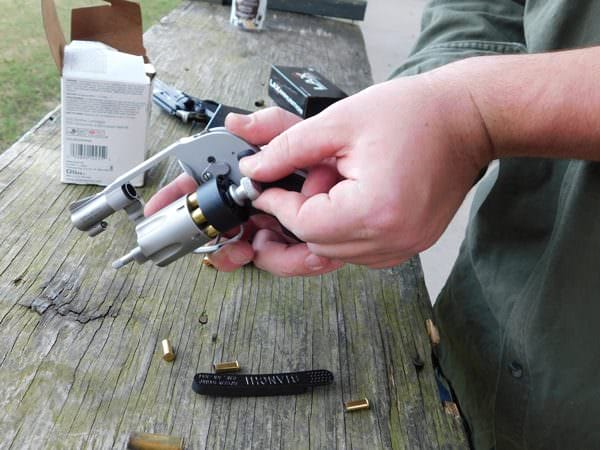
The Take-Away
Even though revolvers aren’t as popular as they once were, there are more reloading options for them now than ever. Loading with loose rounds require no additional investment and is worth training on while not looking at the gun.
Speed Strips are far better, and they carry very slimly on the body. However, like loose rounds, you will need manual dexterity in your hands to get the job done efficiently.
Speedloaders are not as easy to carry, being bulkier, but require fewer motor skills to work with. The same is valid for moon clips if your handgun can accept those. In the unlikely event of a lethal confrontation, you will be very unlikely ever to need to fire your weapon.
However, personal defense has everything to do with unlikely events. Reloading takes practice, and that is even more true with revolver speed strips and speedloaders. Find what works best for you and carry on.

About Terril Hebert:
Terril Hebert is a firearm writer native to south Louisiana. Under his motto—Guns, Never Politics—he tackles firearm and reloading topics both in print and on his Mark3smle YouTube channel, where he got his start. He has a soft spot for ballistics testing, pocket pistols, and French rifles. When he is not burning ammo, he is indulging his unhealthy wildlife photography obsession or working on his latest novel. Scourge of God was published in 2017.”

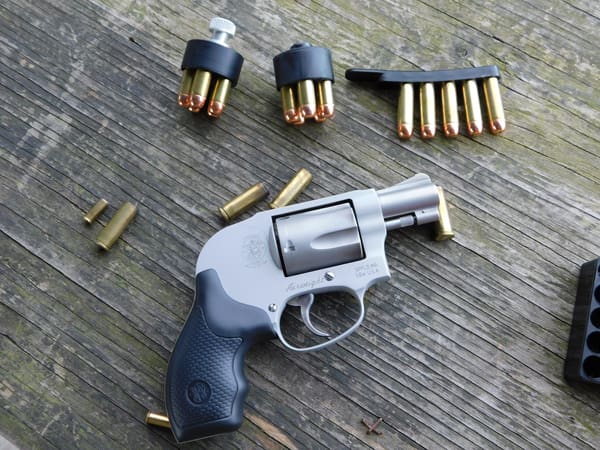



“Self-Defense Revolvers: Speed Strips vs. Speedloaders”
I think one is as good as the other, it’s about training to become proficient…Having said that, speed strips are great IF no speedloader is available for your wheelgun, OR derringer…
‘The number of rou nds fired in citizen-involved self-defense encounters is hard to gauge…’
The number used and the number needed are two very separate things. If you could find a comprehensive study answering that question it would be skewed by panicking civilians doing 15 round mag dumps when one or two rou nds would have sufficed. There’s also a pretty significant difference between carrying a .38 snubby and a 4″ .357 loaded with Buffalo Bores or Double Taps.
Personally I carry a single speed strip with me, and I have no delusion about the time necessary to use it. But like the author said, they have a very slim profile that tucks nicely in your pocket. Even smaller than a single stack magaz ine. The one advantage to these that I never thought of was the ability to top off a cyli nder. I could imagine a scenario where you’ve fired two shots and found cover. It wouldn’t take 2 seconds to top off with a speed strip but moon cl ips or speed loaders would be practically useless in that situation.
I have heard the comment, I don’t remember where:
“If the guy is worth shooting, he’s worth shooting again.”
Situation is everything, but on many occasions a mag dump doesn’t sound like a terrible idea. Works for the police 😉
The biggest arguments against a full mag dump are probably a) hearing damage and b) what your local DA is going to think of you shoo ting a guy 16 times. But you’ll never know how many you needed unless it was one more than what you had. Which does make a study of shots fired in DGUs problematic.
Easy enough to unload a speedloader and hand load a round or two…
but not so easy under stress…nor is using a speed strip
There is no legit reason for me not to be able to legally carry a self defense weapon. Except for my zip code. I live in the glorious people’s republic of the bay area.
So I have to be very discrete when I carry. A j frame in a deep pocket with a pocket holster. And speed strips for reloads. Cause they lay flat.
Funny how a zip code invalidates the constitution and how many POTG are willing to accept this limitation on our rights.
I would counter that a true POTG does NOT accept that situation, and we vote accordingly. It the rest of the voters we need to explain the pervasive violation of their civil rights to. 🤠
HA.
Yeah, the only way you are getting a CCW in ContraCosta is if you are a buddy of the sheriff and you pay the appropriate bribes.
This was a good tip about softening up the Bianchi Speed strips.
If carrying speed strips, use the 8 round capacity strips and skip a space between every two rounds for quicker, easier round insertion. Works for 5 or 6 round revolvers.
I have found that moon clips are the fastest revolver reload. You can stack two moon clips, one on top of the other, in a speed loader pouch, thus carrying twice as much ammo and not worrying about bending the clip.
By far the best speed loader is the not mentioned is the SL Variant. However, it’s made in Germany, almost impossible to find, and when it is, at an outrageous price. 5-Star are slimmer than HKS and, as a result, easier to insert around bigger grips. They are more expensive, but better made, easier to use, and lock up tighter as well.
Jerry Miculek seems to prefer moon clips when he’s in a hurry. (When isn’t he in a hurry?)
That would seem to be a strong argument in their favor.
https://www.youtube.com/watch?v=0FbUMqoyjDw
Jerry also shoots 9mm out of that big 8 shot, making moon cl ips kind of a necessity.
Very good overview. Getting the wife a Taurus 85(her choice) and while she may eventually carry it legally I MAY throw it in my pocket.
I use hks loaders with my .44 when hunting. I can load and unload easy. I allow the rounds to fall back into the loader and lock them. Never lost or dropped a round while in the stand.
Have you ever even needed to reload? Unless we are talking about 1,600+ pound polar bears, moose, or draft horses, I cannot picture anything shrugging off a single hit, much less multiple hits.
I have carried a snub for years and usually have speed strips since the are flat and flexible.
For years i carried them fully loaded with 6 or even 8 rounds.
Over the years i figured out that after loading 5 i was going to drop them so now i have 5 loaded in two strips.
Smith has the advantage on speed loaders as it can use HKS, Safariland, or 5Star. (I have small grips with a Tyler T).
On my LCR i can only make the 5 Star work and they work well. More expensive than HKS but i generally carry one and a strip or two.
No doubt that recolvers ade slower to load but i can get a snub into play faster than a tiny nine or LCP. Thats gotta be worth something….maybe just piece-of-mind.
I was in LE when the strips and loaders came out. We were taught to use the dump pouches but as soon as alternatives came out everyone switched to strips first and later the loaders. There used to be a carrier for the speedloaders which carried half the rounds inside your belt and the rest outside, which was very easy to conceal, but I didn’t work that much undercover, so did not need it. My 2-inch was/is a Colt Detective Special with shroud attached. Prefer the Safariland loaders but for some firearms they aren’t made and HKS does make them.
Bought 2 DeSantis second six speed loader holders for my K frame.
Shop around, prices vary
I have forsaken any pretense of being able to reload, during a confrontation. Sure, I carry a spare magazine once in a while but my main goal will be to save myself first, shoot later.
My hope is, if I’m not part of that 92% of non-discharging incidents, is that my first shot will disrupt whatever is going on. You’d best believe I’ll be behind cover and my target clearly identified. If not, I won’t shoot.
If one shot won’t seem to manage the threat, I may have to stand down and ride it out. Of course, who knows what will come down the pike. Hopefully nothing.
Now revolvers
“In practice, there is indeed the temptation to keep loading until the cylinder is full when a partial reload would be preferable.”
The problem with a partial reload in a revolver is indexing the cylinder properly when closing the action. (Is that the proper term?)
When your heart is in your throat and fingers turn to flippers…
It’s a coin toss either way. Keep yanking the trigger, or properly align the cylinder, or fully reload.
I foresee the exact same problem Geoff PR.
And yes, you used correct terminology as far as I am concerned.
My first concealed carry gun was a Taurus 85. Always had a HKS speedloader with it. Had to relieve the left grip with a Dremel Tool to get it to work. Had been trained on speedloaders as a reserve cop in Ohio, so I never used strippers, which are deadly slow by comparison. Since then, if I’m carrying a K-frame, always 2 to 4 speedloaders with me.
Practice, practice, practice !
My preferred method for reloading a revolver is another revolver.
Yeah, what about the ol New York reload?
When my 2.5 inch Model 66 my 1st gun was my EDC. I always carried speed strips.
No easy way to carry a speed loader comfortably and not making a lump on you someplace(showing).
Like some of the other old farts here I started my reserve LE career (such as it is) in 1991 carrying a Smith 686. I had six rounds of very stout 125 grain Federal .357s in the pistol and two speed loaders on my belt. I didn’t feel poorly armed in those days and if I had to go back to a wheel gun today I’d still be okay. I still carry a snubby as an off duty pistol on occasion. These days its an old stainless Smith 640 .357 or a Charter Arms Bulldog .44 special. Hey I like big holes. I carry 2 speed loaders for the pistols to give me 15 rounds total and a hot .38 +p or .44 special will stop a fight pretty quickly. I’ve practiced often enough to feel competent with a speed loader and I think that I’d be able to take care of business.
Think the real solution is to learn how to load like idris elba in the dark tower.
I occasionally carry a S&W model 649 bodyguard. The six round speed strip fits neatly in the blue jeans change pocket. The problem that I have had with speed strips is that the little pull tab eventually breaks.
An excellent article on why revolvers make bad defense guns. They’re good enough for the first 5 or 6 shots then, not so much. Sorry wheelboyz, there’s just no way to sugar coat it. Get into a prolonged shootout with a bad guy armed with a hi-cap 9mm and you’re toast.
LOL.
Prefer Speedloaders. Strips are for chumps.
Comments are closed.